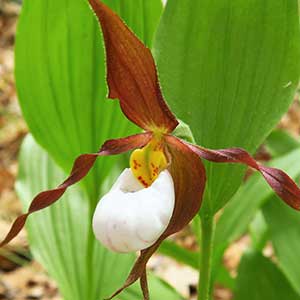Cypripedium montanum
Cypripedium kentuckiense
mountain lady slipper, mountain lady's-slipper, white lady's-slipper
ivory lady's-slipper, Kentucky lady's slipper, purloined slipper, southern lady's slipper
4–6, inserted toward base or scattered along stem, alternate, erect, ascending, or spreading;
blade suborbiculate or broadly ovate to elliptic-lanceolate, 3.3–17 × 2.5–9.5 cm.
3–6, rather evenly spaced along stem, alternate, spreading;
blade broadly ovate to ovate-lanceolate or ovate-elliptic, 13–24 × 4.3–15 cm.
1–3;
sepals greenish, suffused, often heavily, with reddish brown or madder, or rarely clear green;
dorsal sepal lance-acuminate to elliptic-lance-acuminate, 33–60 × 8–16 mm;
lateral sepals connate;
synsepal 30–60 × 6–18 mm;
petals spreading-deflexed, same color as sepals, spirally twisted, linear to linear-lanceolate, 36–77 × 3–5 mm;
lip white, rarely suffused with magenta, obovoid or oblance-ovoid to oblance-fusiform, 19–33 mm;
orifice basal, 13–22 mm;
staminode lanceoloid to broadly ovoid or ellipsoid-ovoid.
1–2;
sepals greenish or yellowish, heavily spotted, striped, reticulately marked with dark reddish brown or madder;
dorsal sepal broadly ovate to ovate and elliptic, 61–126 × 24–65 mm;
lateral sepals connate;
synsepal 55–103 × 12–40 mm;
petals spreading-deflexed, same color as sepals, spirally twisted, linear, 84–156 × 7–15 mm;
lip ivory to pale yellow, obovoid, (41–)53–65 mm;
orifice basal, 27–37 mm;
staminode broadly ovoid, ovoid-cordiform, or ovoid-deltoid.
Cypripedium montanum
Cypripedium kentuckiense
Plants of Cypripedium montanum grown in exposed, relatively sunny situations have the ascending leaves inserted along the basal portion of the stem and the flowers displayed well above the leaves. In shadier, especially sheltered sites, the spreading leaves may be more evenly scattered along the stem. In this species the apical margin of the orifice of the lip is usually acute, in common with C. candidum, and in contrast to the usually obtuse margin in C. parviflorum; this difference can aid determination of discolored herbarium specimens. Hybrids of C. montanum and C. parviflorum have been designated C. ×columbianum Sheviak. See 11. C. parviflorum for a general discussion of hybridization and variation within and between related species.
(Discussion copyrighted by Flora of North America; reprinted with permission.)
The brief nomenclatural history of Cypripedium kentuckiense is remarkably confused. The plant was originally described, without Latin diagnosis, as C. daultonii Soukup; this nomen nudum came into general usage prior to Reed’s publication. Subsequently, an earlier name, C. furcatum Rafinesque, was proposed as conspecific, but Rafinesque’s description is not adequate for a positive determination.
Cypripedium kentuckiense is very distinctive. In addition to the very large flowers and pale coloring of the lip, the form of the orifice is unique. In related species the orifice is a restricted opening in the adaxial surface of the lip; in C. kentuckiense the orifice replaces the basal portion of the adaxial surface, the sides of the lip terminating abruptly at the orifice without curving toward the horizontal. In herbarium specimens this detail is obscured, but the cavernous nature of the orifice is emphasized by the adaxial surface descending from the apical margin of the orifice toward the apex of the lip; the obovoid lip appears to hang from the margin of the orifice, and the lip is not particularly slipper-shaped. In contrast, in related species, the adaxial surface of the lip surrounds the orifice and extends forward toward the apex, forming a more convincing slipper. These distinctions hold virtually throughout the known populations of C. kentuckiense; only in two Arkansas populations is the lip form suggestive of related species. The Arkansas populations may reflect very limited introgression from C. parviflorum var. pubescens.
(Discussion copyrighted by Flora of North America; reprinted with permission.)
- Local floras:
BC,
CA,
OR,
WA
- Local Web sites:
CalFlora,
CalPhotos,
Flora NW,
PNW Herbaria,
Turner Photog.
WildflowerSearch
iNaturalist (observations)
USDA Plants Database
- LBJ Wildflower Center
- SEINet
- Plants of the World Online
- Encyclopedia of Life
- Wikipedia
- Google Image Search


